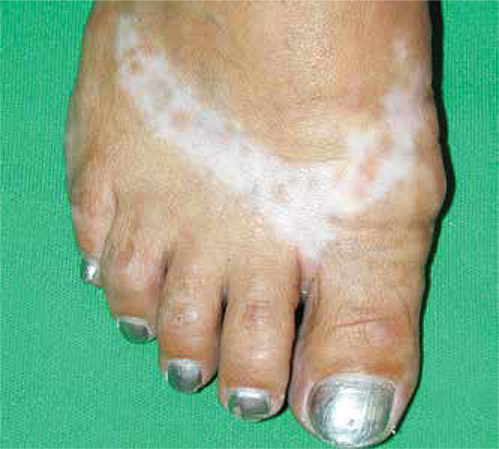Hypopigmentation disorders in adults: general and differential diagnoses
Keywords:
Hypopigmentation, depigmentation, acquired disorders.Abstract
Hypopigmented and depigmented lesions are a heterogeneous group of dermatological diseases that can be located, or generalized. Dermatologists should be familiar with the various differential diagnoses including malignant or benign manifestation leucodermic skin and not forgetting the patient systemic approach and the use of diagnostic support tools.
Author Biography
Claudia Juliana Díaz
Médica dermatóloga; docente, Escuela de Dermatología y Cirugía Dermatológica, Facultad de Salud, Universidad del Valle, Cali, Colombia
References
2. Bolognia JL. A clinical approach to leukoderma. Int J Dermatol. 1999;38:568-723.
3. Gupta LK, Singhi MK. Wood's lamp. Indian J Dermatol Venereol Leprol. 2004;70:131-5.
4. Lai LG, Xu AE. In vivo reflectance confocal microscopy imaging of vitiligo, nevus depigmentosus and nevus anemicus. Skin Res Technol. 2011;17:404-10.
5. Read RW, Holland GN, Rao NA, Tabbara KF, Ohno S, Arellanes-García L, et al. Revised diagnostic criteria for Vogt-Koyanagi-Harada disease: Report of an international committee on nomenclature. Am J Ophthalmol. 2001;131:647-52.
6. Boissy RE, Manga P. On the etiology of contact ⁄occupational vitiligo. Pigmentary Cell Research. 2004;17:208-14.
7. Bajaj AK, Saraswat A, Srivastav PK. Chemical leucoderma: Indian scenario, prognosis, and treatment. Indian J Dermatol. 2010;55:250-4.
8. Ghosh S, Mukhopadhyay S. Chemical leucoderma: A clinico-aetiological study of 864 cases in the perspective of a developing country. Br J Dermatol. 2009;160:40-7.
9. Teulings HE, Tjin EP, Willemsen KJ, Krebbers G, van Noesel CJ, Kemp EH, et al. Radiation-induced melanoma-associated leucoderma, systemic antimelanoma immunity and disease-free survival in a patient with advanced-stage melanoma: A case report and immunological analysis. Br J Dermatol. 2013;168:733-8.
10. Quaglino P, Marenco F, Osella-Abate S, Cappello N, Ortoncelli M, Salomone B, et al. Vitiligo is an independent favourable prognostic factor in stage III and IV metastatic melanoma patients: Results from a single-institution hospital-based observational cohort study. Ann Oncol. 2010;21:409-14.
11. Arpaia N, Cassano N, Vena GA. Regressing cutaneous malignant melanoma and vitiligo-like depigmentation. Int J Dermatol. 2006;45:952-6.
12. Pandya AG. Top accessed article: Propionibacterium acnes and the pathogenesis of progressive macular hypomelanosis. Arch Dermatol. 2012;148:1256.
13. Westerhof W, Relyveld GN, Kingswijk MM, de Man P, Menke HE. Propionibacterium acnes and the pathogenesis of progressive macular hypomelanosis. Arch Dermatol. 2004;140:210-4.
14. Yang S, Makredes M, O'Donnell P, Levin NA. A case of Hansen disease presenting as tinea versicolor. Dermatol Online J. 2013;19:7.
15. Eichelmann K, González Gonzalez SE, Salas-Alanis JC, Ocampo-Candiani J Leprosy. An update: Definition, pathogenesis, classification, diagnosis, and treatment. Actas Dermosifiliogr. 2013;104:554-63. Esta referencia está buena
16. Pandhi RK, Bedi TR, Bhutani LK. Leucoderma in early syphilis. Br J Vener Dis. 1977;53:19-22.
17. Gutiérrez-Pascual M, Vicente-Martín FJ, López-Estebaranz JL. Lichen sclerosus and squamous cell carcinoma. Actas Dermosifiliogr. 2012;103:21-8.
18. Monsálvez V, Rivera R, Vanaclocha F. Lichen sclerosus. Actas Dermosifiliogr. 2010;101:31-8.
19. Mimouni D, David M, Feinmesser M, Coire CI, Hodak E. Vitiligo-like leucoderma during photochemotherapy for mycosis fungoides. Br J Dermatol. 2001;145:1008-14.
20. Sánchez JL, Vázquez M, Sánchez NP. Vitiligo like macules in systemic scleroderma. Arch Dermatol. 1983;119:129-33.
21. Serup J. Clinical appearance of skin lesions and disturbances of pigmentation in localized scleroderma. Acta Derm Venereol. 1984;64:485-92.
22. Jawitz JC, Albert MK, Nigra TP, Bunning RD. A new skin manifestation of progressive systemic sclerosis. J Am Acad Dermatol. 1984;11:265-8.
23. Rai VM, Balachandran C. Pseudovitiligo in systemic sclerosis. Dermatol Online J. 2005;11:41.
24. Schmitt CE, Fabi SG, Kukreja T, Feinberg JS. Hypopigmented cutaneous sarcoidosis responsive to minocycline. J Drugs Dermatol. 2012;11:385-9.
25. Gautam M, Patil S, Munde P. Skin as a marker of internal disease: A case of sarcoidosis. Indian J Dermatol. 2011;56:439-41.
26. Arrunategui A, Trujillo RA, Marulanda MP, Sandoval F, Wagner A, Alzate A, et al. HLA-DQ3 is associated with idiopathic guttate hypomelanosis, whereas HLA-DR8 is not, in a group of renal transplant patients. Int J Dermatol. 2002;41:744-7.
27. Winship IM, Connor JM, Beighton PH. Genetic heterogeneity in tuberous sclerosis: Phenotypic correlations. J Med Genet. 1990;27:418-21.
28. Al-Dawsari NA, Shahab RK. Amyloidosis cutis dyschromia: A rare form of primary cutaneous amyloidosis. Dermatol Online J. 2014;20:223-8.
29. Kurian SS, Rai R, Madhukar ST. Amyloidosis cutis dyschromica Indian Dermatol Online J. 2013;4:344-6.
30. Eisenbarth GS, Gottlieb PA. Autoinmune polyendocrine syndrome. N Engl J Med. 2004;350:2068-79.
31. Cutolo M. Autoimmune polyendocrine síndromes. Autoimmun Rev. 2014;13:85-9.
How to Cite
Downloads

Downloads
Published
How to Cite
Issue
Section
| Article metrics | |
|---|---|
| Abstract views | |
| Galley vies | |
| PDF Views | |
| HTML views | |
| Other views | |






